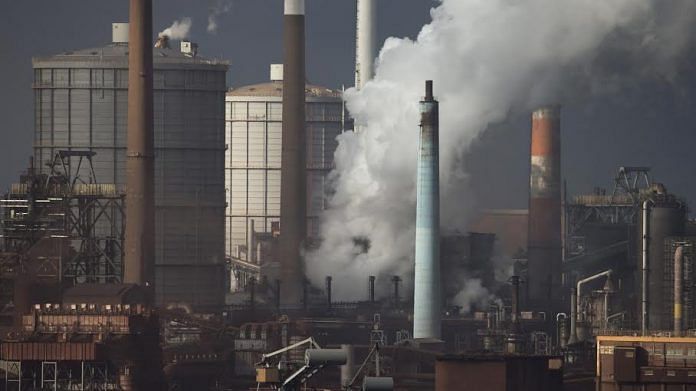
New Delhi: Last week, India urged G20 members having per capita greenhouse gas (GHG) emissions above the global average to bring it down to the world average, in order to vacate carbon space for developing nations.
The statement comes at a time when the EU Commission is pushing for the world’s first carbon border tax on imported goods like carbon-intensive steel. The 27-nation bloc plans to levy the tax in a phased manner from 2026. It directs non-EU companies exporting to Europe to pay the same price for their carbon footprint in Europe as European companies.
On Monday, China said the proposed tax will expand climate issues into trade and goes against the free international trade system.
Carbon Border Adjustment Mechanism (CBAM) is part of the EU’s ambitious new targets to curb climate change ahead of the 26th United Nations Climate Change conference (COP26) in Glasgow at the end of this year. In April, the EU pledged to cut carbon emissions by at least 55 per cent by 2030, compared with 1990 levels. Previously, the target was 40 per cent.
ThePrint explains carbon border tax and why countries, including India, are opposing it.
Carbon pricing and carbon border tax
A carbon border tax is a tax on carbon emissions imposed on imported goods from countries with less strict climate policies. It aims to create a level playing field between imports and domestic production.
The main purpose of the EU’s proposed Carbon Border Adjustment Mechanism (CBAM) is to address “carbon leakage” — when companies decamp to places with cheaper pollution costs and looser climate regulations.
Carbon border tax is meant to run parallel to carbon pricing on domestic industries. Some 40 countries have a price on carbon within their own borders.
Carbon pricing can be in two forms: A traditional tax or a “cap-and-trade scheme”. Cap-and-trade systems, such as the EU Emissions Trading System (ETS), impose a limit on greenhouse gas (GHG) emissions that can be emitted every year, called ‘carbon credits’. Industries with low emissions can sell their extra allowances to larger emitters. A traditional tax, meanwhile, directly sets a price on carbon, unlike an ETS in which the emission reduction outcome of a carbon tax is not pre-defined.
India does not have a price on carbon, though it has been implemented in indirect forms through mechanisms like a coal cess.
Also read: Why India should join the race to net zero emissions
What is CBAM?
In December 2019, CBAM was introduced by the European Commission as part of the larger European Green Deal. On 16 September 2020, it became a legislative proposal, among other initiatives for 2021.
In March this year, the EU Parliament adopted a resolution to implement CBAM. The proposal is yet to be approved by the European Council, and the European Parliament. Currently, the UK and the US are also considering such proposals.
There have been concerns that CBAM is inconsistent with the World Trade Organization’s measures designed to prevent importing countries from discriminating against particular exporting countries.
Second, there is a fear that this is the EU’s revenue-raising scheme for the pandemic recovery.
Third, there has been pushback from local European industries, like steel and fertilisers, who rely on imported materials that will now have to buy more carbon credits at rising prices.
How does carbon border tax work
Using CBAM as a basis, the importers of goods covered by a border tax will have to buy certificates that would cover the emissions during production of the goods. The price will mirror that decided by the country’s own emission trading system.
In an op-ed for Nikkei, Spanish economist Alicia García-Herrero estimated that the carbon border tax, priced according to ETS, will be at least 50 euros per tonne by 2035.
Also read: How whales and plankton are working together to store and reduce the world’s carbon emissions
Why is India opposed to it
India, along with other developing countries, has long opposed the EU’s proposed carbon border tax. In April, it issued a joint statement with the BASIC bloc — Brazil, South Africa, India and China — calling CBAM “discriminatory“. The concern is that the border tax will ramp up prices of their goods in Europe and shrink demand.
The BASIC group also said the EU’s proposal goes against the UN principle of Common but Differentiated Responsibilities and Respective Capabilities (CBDR–RC). The CBDR-RC acknowledges that richer countries have a responsibility of providing financial and technological assistance to developing and vulnerable countries to fight climate change.
A carbon border tax is worrisome for India as it is the EU’s third largest trading partner.
In 2020, the EU accounted for 11.1 per cent of India’s total global trade. India’s exports to the EU were also worth $41.36 billion in 2020-21, according to data from the commerce ministry.
The tax could “create serious near-term challenges for companies with a large greenhouse gas footprint”, noted consultancy group BCG in an analysis in June 2020.
It also said mechanisms like CBAM could cause disruptions in a global trading system “already roiled by tariff wars, renegotiated treaties, and rising protectionism”.
(Edited by Neha Mahajan)
Also read: Why buying a Tesla in India or China may not cut your carbon emissions

COMMENTS